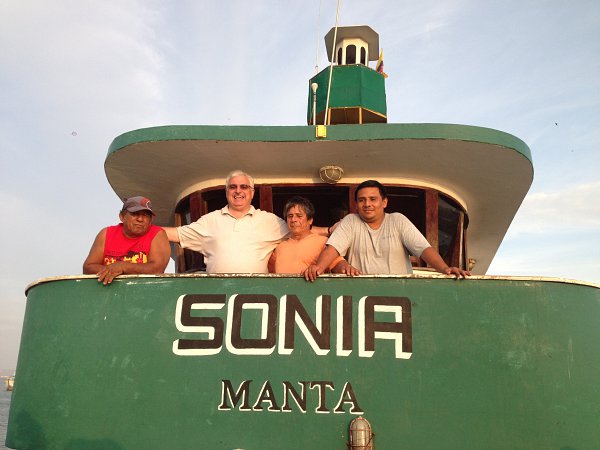IPNLF visits Ecuador's tuna mecca


9th April 2014
IPNLF Chairman John Burton visited Manta, Ecuador's "tuna fishing mecca" during March 2014. His mission? To understand the pole and line fishing industry in one of the East Pacific’s largest fishing nations, and to find out how IPNLF could support the men and women involved in the fishery.
Tuna is a big business in Ecuador. In 2012, the nation reportedly caught over 217,000 metric tons of tuna, accounting for over 40% of total tuna catches in the Eastern Pacific. This entire tonnage of fish, (alongside substantial exports), was processed by 14 plants holding a collective processing capacity of 400 million tonnes. The numbers go on.
Yet big numbers don’t necessarily add up to responsible business, directly benefitting fishermen, their families and communities. Indeed, this is reflected in the state of the nation’s traditional pole and line sector. Once a valued fishery, consisting of 70 vessels landing some 10,000 tonnes, recent decades have witnessed a dramatic dwindling of the fleet – today, only 7 vessels landing 1,000 tonnes. This decline is, in part, due to the higher prices and margins received on tuna caught by purse seine.
But with the rising prominence of the benefits of pole and line fishing, to not just consumers, but also fishermen and their environment, the market now looks to change. And the size of Ecuador’s fishing sector means that there is real opportunity to impact many lives.
To explain, I was visiting the fishery in my capacity as Chairman of the International Pole & Line Foundation, in an effort to understand the challenges and opportunities faced by the sector, and how we, as a Foundation with the support of international industry, could support the re-invigoration of this traditional fishery.
During my visit, I was staying for the post part in Manta, Ecuador’s largest seaport located about mid-way down the country’s coastal stretch (on one of the westernmost points of South America). Self-proclaimed as “the world capital of tuna”, the city of 260,000 is home to South America’s largest fishing fleet and claims the highest percentage of unloading and the largest quantity of seafood processing.
On arrival, I met with a group of fishermen, NGOs and government representative to discuss their experiences and the work of IPNLF, including Ramon Montano, Ecuador’s Under Secretary of Fishery Resources, Xavier Chalen and Luis Suarez from Conservation International and Augusto Lopez and Christopher Roig of the Manta Pole & Line Association.
Gratefully relying upon Cristina Rodriguez from Salica for translation, my presentation was met with great interest and lively questions. Ramon Montano, the Under Secretary for Fisheries, and Augusto Lopez, the President of the Manta Pole & Line Association both agreed to join IPNLF as a member, valuing our support.....
This article was first published on the IPNLF website, to read the full article, click here